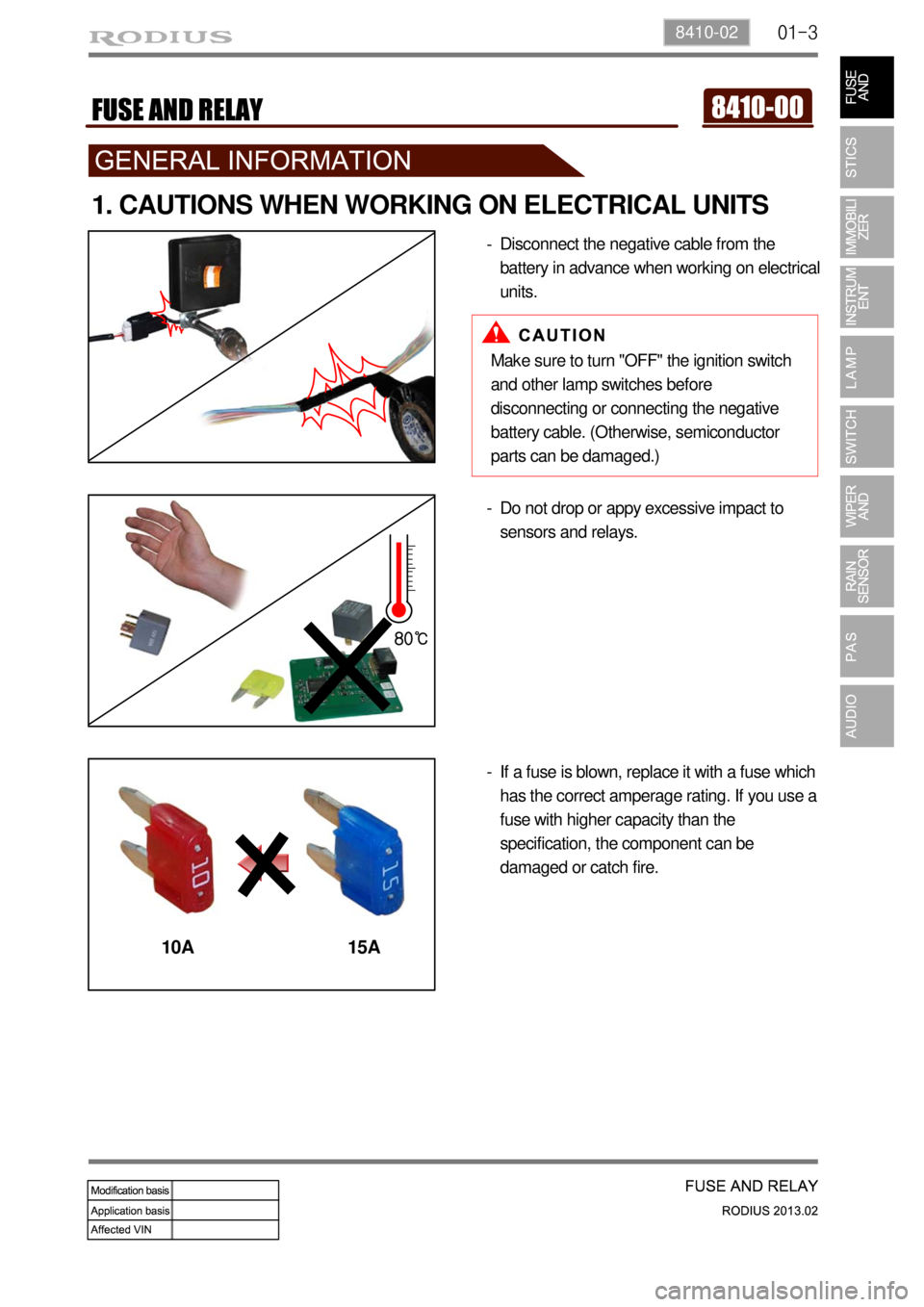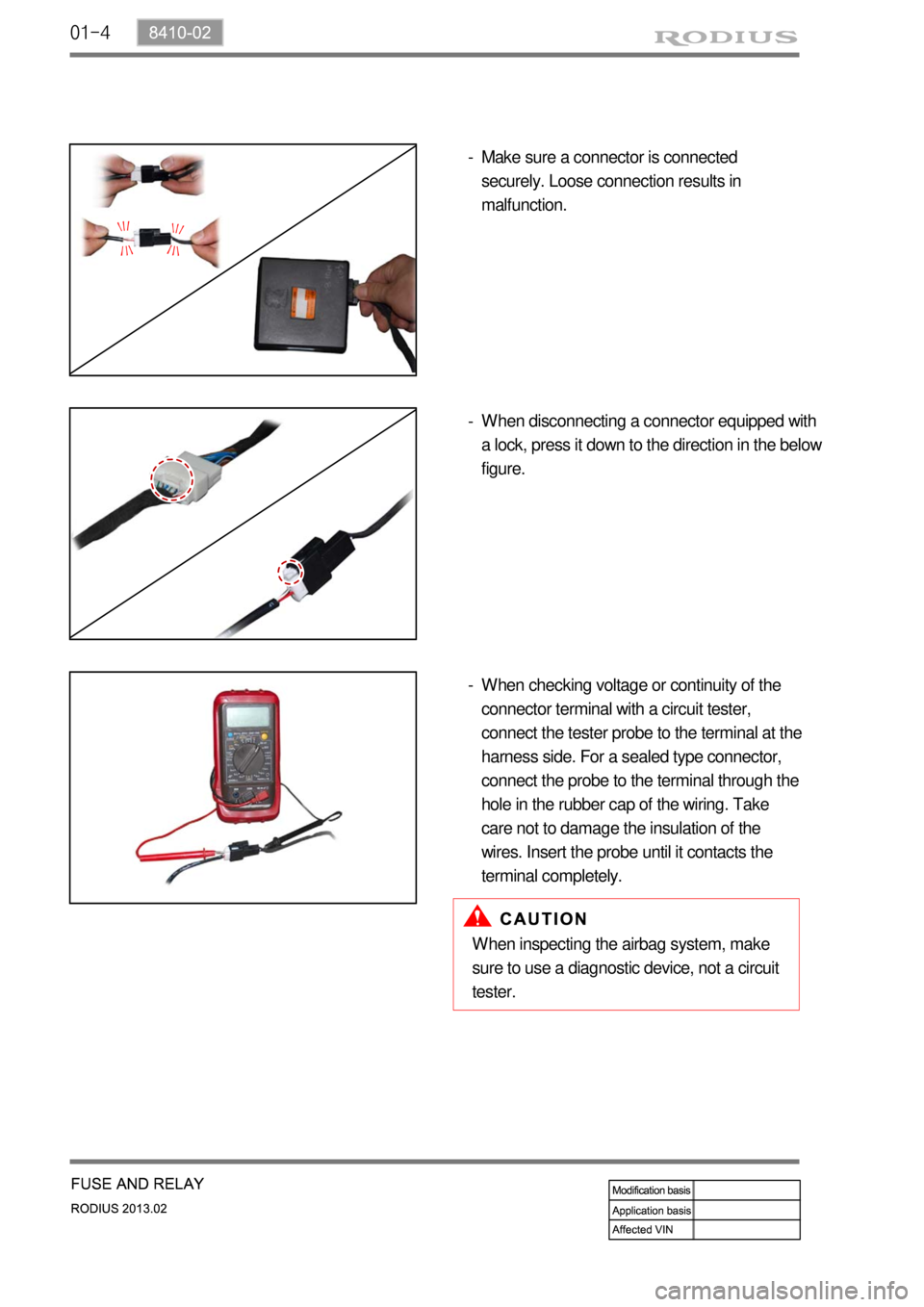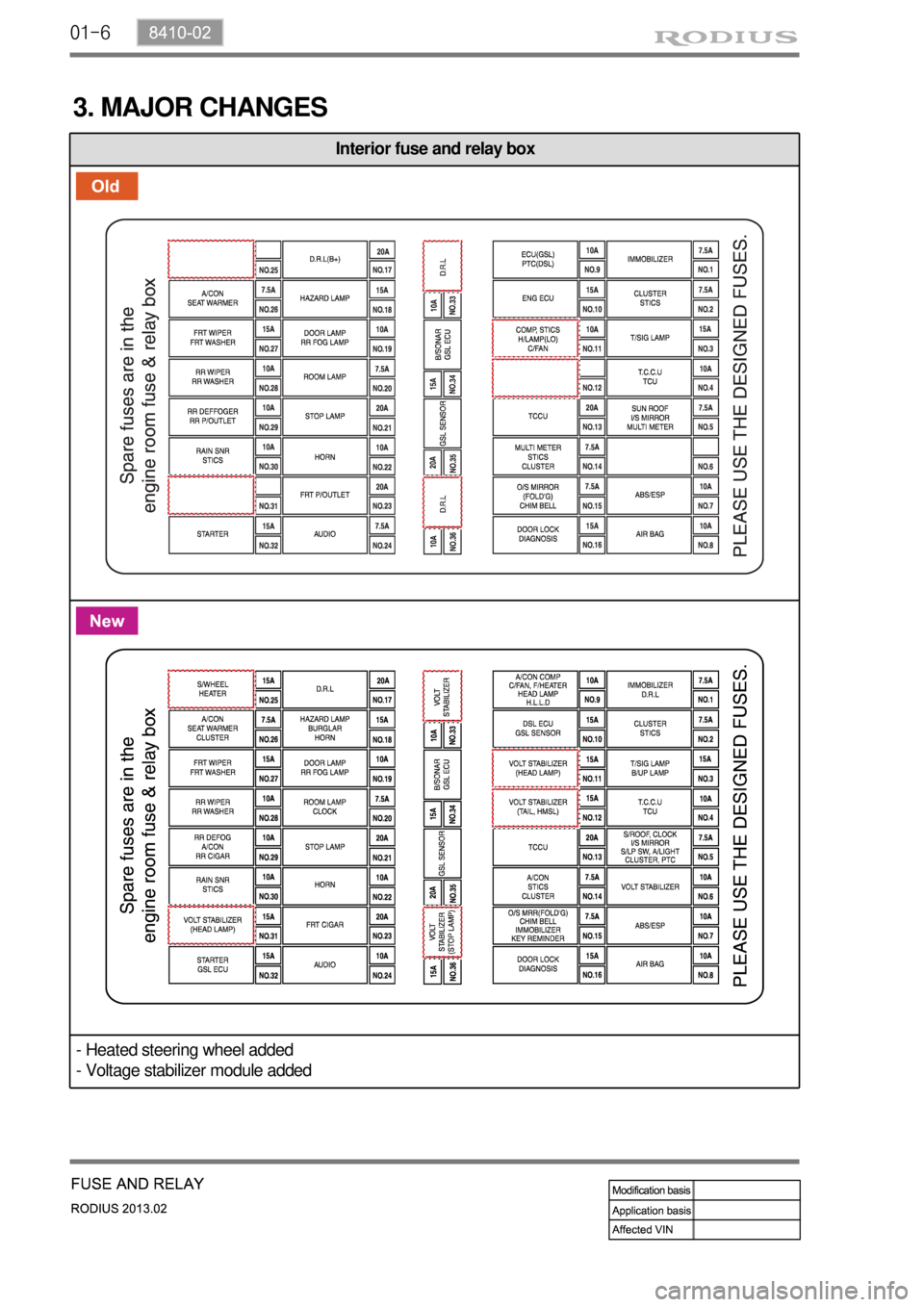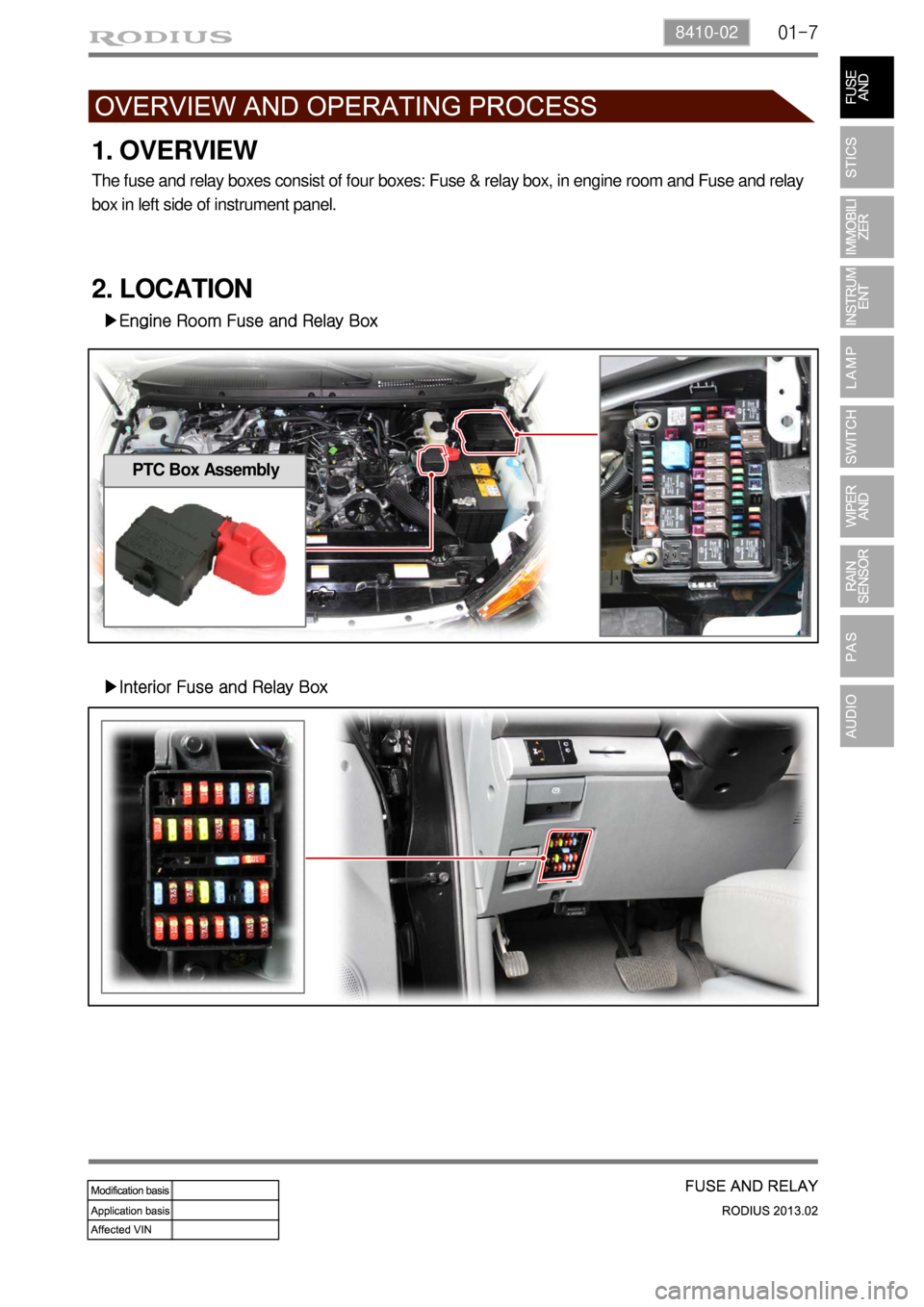SSANGYONG TURISMO 2013 Service Manual
Manufacturer: SSANGYONG, Model Year: 2013, Model line: TURISMO, Model: SSANGYONG TURISMO 2013Pages: 796, PDF Size: 78.99 MB
Page 411 of 796

10-6
2) Accelerating with the Cruise Control System
(1) While the cruise control system is running
Push up the ACCEL switch of the cruise control lever and hold it until the desired speed is reached
without an accelerator pedal intervention.
When the desired speed is reached, release the lever. 1.
2.
(2) While the cruise control system is not running
Accelerate using the accelerator pedal over 36 km/h.
Push up the ACCEL switch of the cruise control lever and hold it.
And then release the accelerator pedal slowly.
When the desired speed is reached, release the lever. 1.
2.
3.
4.
(3) Tap-up while the cruise control system is running
Push up the ACCEL switch of the cruise control lever less than 0.5 second per one switching while
the cruise control system is running. This is a tap-up switching.
When you operate a tap-up switching, the vehicle is accelerated by 1.3 km/h over the previous set
speed.
If you want to accelerate to 13 km/h, operate the tap-up switching ten times without accelerating
with the cruise control system. 1.
2.
3.
Page 412 of 796

10-78510-23
3) Decelerating with the Cruise Control System
(1) While the cruise control system is running
Push down the DECEL switch of the cruise control lever and hold it until the desired speed is
reached without a brake pedal intervention. But the cruise control system cannot maintain the
cruise function at less than 34 km/h.
When the desired speed is reached, release the lever. 1.
2.
(2) When the cruise control system is not running
Push down the DECEL switch of the cruise control lever and hold it.
And then release the accelerator pedal slowly.
When the desired speed is reached, release the lever. But the cruise control system cannot
maintain the cruise function at less than 34 km/h. 1.
2.
3.
(3) Tap-down while the cruise control system is running
Push down the DECEL switch of the cruise control lever less than 0.5 second per one switching
while the cruise control system is running. This is a tap-down switching.
When you operate a tap-down switching, the vehicle is decelerated by 1.0 km/h below the previous
set speed.
If you want to decelerate to 10 km/h, operate the tap-down switching ten times without the brake
pedal intervention. 1.
2.
3.
Page 413 of 796

10-8
4) Recovery of Set Speed (RESUME)
Even if the cruise control is cancelled, the previous set cruise speed can be recovered by pushing
(Type A) or pulling (Type B) toward the cruise control lever when the current vehicle speed is over 36
km/h without an acceleration intervention. But if you turn off the ignition switch, the memorized set
speed is cleared and you cannot recover the previous set speed.
The resume position should only be used if the driver is fully aware of this speed and wishes to
resume this particular speed.
Page 414 of 796

10-98510-23
5) Normal Cancellation of the Cruise Control
The cruise control system will be canceled when one or more items of the following conditions are
applied;
Keep the main cruise control switch in the neutral position when not using the cruise control.When the brake pedal is depressed.
When the cruising speed is downed less than 38 km/h.
When the OFF switch is operated by pulling the cruise control lever (Type A) or by pushing the ON-
OFF switch of the cruise control lever (Type B).
When ESP is activated.
When applying the parking brake when driving.
When using the clutch in order to shift (M/T only).
And the cruise control system can be operated again in driving state. 1.
2.
3.
4.
5.
6.
Page 415 of 796

10-10
(2) Using the Cruise Control on Hills
How well the cruise control works on hills depends on the speed, load, and the steepness of the hill.
When going up steep hills, you may have to depress the accelerator pedal to maintain your speed.
When going downhill, you may have to brake or shift to a lower gear to keep your speed down.
Applying the brake takes you out of the cruise control.
And the cruise control system cannot be operated again in driving state. In this case, you should stop
the vehicle, and turn off the ignition switch and then turn it on again. After you do that, you can use the
cruise control s
ystem again. But if the cruise control system isn’t recovered, you should contact
a Ssangyong Dealer for diagnosis of the cruise control system.
Abnormal changes of the gear selector lever can damage the engine. Do not move the gear shift
lever to Neutral while driving at the set speed. Automatic transmission damage may result.
The speed that has been set may not be maintained on uphill or downhill slopes.
The speed may drop to less than the set speed on a steep uphill grade. The accelerator must be
used if you want to maintain that speed.
The speed may increase to more than the set speed on a steep downhill grade. When the speed
increases too much, turn off the cruise control. -
-
-
-
(1) Abnormal Cancellation of the Cruise Control
When the rapid deceleration is applied without braking.
When the rapid acceleration is applied without acceleration pedal intervention.
When the cruise control lever is failed.
When the brake switch and the brake light switch input signal are implausible. 1.
2.
3.
4.
Page 416 of 796

01-38410-02
1. CAUTIONS WHEN WORKING ON ELECTRICAL UNITS
80℃
10A 15A
Disconnect the negative cable from the
battery in advance when working on electrical
units. -
Make sure to turn "OFF" the ignition switch
and other lamp switches before
disconnecting or connecting the negative
battery cable. (Otherwise, semiconductor
parts can be damaged.)
Do not drop or appy excessive impact to
sensors and relays. -
If a fuse is blown, replace it with a fuse which
has the correct amperage rating. If you use a
fuse with higher capacity than the
specification, the component can be
damaged or catch fire. -
Page 417 of 796

01-4
Make sure a connector is connected
securely. Loose connection results in
malfunction. -
When inspecting the airbag system, make
sure to use a diagnostic device, not a circuit
tester.When disconnecting a connector equipped with
a lock, press it down to the direction in the below
figure. -
When checking voltage or continuity of the
connector terminal with a circuit tester,
connect the tester probe to the terminal at the
harness side. For a sealed type connector,
connect the probe to the terminal through the
hole in the rubber cap of the wiring. Take
care not to damage the insulation of the
wires. Insert the probe until it contacts the
terminal completely. -
Page 418 of 796

01-58410-02
2. CHECKING CABLES AND WIRES
Check for loose connection or rust.
Check terminals and wires for corrosion due to electrolyte leakage.
Check terminals and wires for open circuit.
Check the wire insulation and coat for damage, cracks or deterioration.
Check if the conductive parts of the terminals do not contact with vehicle body or other metal
parts.
Check that the grounding part has continuity with mounting bolts and vehicle body.
Check that wires are properly routed.
Make sure that wires are securely fixed to avoid contact with sharp body parts and hightemperature
parts, such as the exhaust manifold and exhaust pipes.
The rotating parts, such as fan pulley and fan belt, perturbative parts and wiring should be
secured tightly at regular intervals.
Secure the wiring between the fixed parts, such as the vehicle body, and vibrating parts, such
as the engine, after slackening it slightly to prevent it from being damaged. -
-
-
-
-
-
-
-
-
Page 419 of 796

01-6
3. MAJOR CHANGES
Interior fuse and relay box
- Heated steering wheel added
- Voltage stabilizer module added
Page 420 of 796

01-78410-02
1. OVERVIEW
The fuse and relay boxes consist of four boxes: Fuse & relay box, in engine room and Fuse and relay
box in left side of instrument panel.
2. LOCATION
▶Engine Room Fuse and Relay Box
▶Interior Fuse and Relay Box
PTC Box Assembly